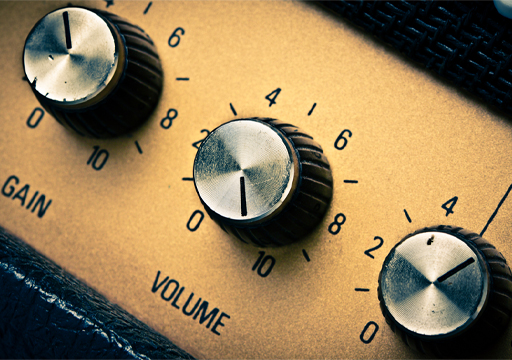1.3 Creating dynamic change in music
Dynamics is the term used in music to describe loudness. Scientifically, loudness can be measured in decibels. Musical dynamics range from very quiet to very loud sounds and can change either suddenly or over time, creating differing effects of contrast. Performers can vary dynamics by using a gradual decrease in volume called a diminuendo, or a gradual increase in volume or crescendo when playing either an individual note or a longer section of music. However, there are other musical devices which composers can use to change dynamics which you will explore now.
Activity 3
Listen to the audio extracts and choose one of the three statements which describes a notable feature of the dynamics:
Statement 1: The music includes a gradual crescendo.
Statement 2: The music is predominately quiet, with loud chord sounded in the middle of the extract.
Statement: 3: The music moves between soft and very loud and is partly dependent on the instrumental forces and the texture of the music.
Two lists follow, match one item from the first with one item from the second. Each item can only be matched once. There are 3 items in each list.
-
Statement 2: The music is predominantly quiet, with loud chord sounded in the middle of the extract.
-
Statement 3: The music moved between soft and very loud and is partly dependent on the instrumental forces and the texture of the music.
-
Statement 1: The music includes a gradual crescendo.
Match each of the previous list items with an item from the following list:
a.Audio 32: Haydn, Surprise Symphony
b.Audio 34: Rossini, ‘Overture’, Barber of Seville
c.Audio 33: Nirvana, Smells like teen spirit
- 1 = a,
- 2 = c,
- 3 = b
Discussion
Statement 1 described the dynamic movement in Audio 34 where the music gradually became louder throughout the extract. This is an example of what is known as the ‘Rossini Rocket’ or ‘Rossini crescendo’ and was used by the Italian composer Gioacchino Rossini in many of his operas. In creating his distinct crescendo, Rossini did not simply increase the volume of the music, but combined a number of musical devices to build intensity. This included shortening melodic material during repetition (giving the impression that the music was speeding up), increasing the harmonic pace (moving through chord sequences at a faster rate), gradually adding instruments to increase the forces playing, and making greater use of register to increase the range of the overall sound. This demonstrates that increasing the dynamic of the music is not restricted to volume alone.
Statement 2 described the dynamic movement in Audio 32, known as the ‘surprise’ symphony, due to the inclusion of a loud chord occurring at the end of a very quiet (pianissimo) melody. This was intended as a musical joke by the composer Haydn, and the effect is similar to the other musical joke we heard in Audio 30 in presenting the listener with something unexpected. Notice how the forces and textures were carefully controlled by Haydn: the fortissimo chord included the full orchestra, which contrasted with the single pianissimo melody played by the violins, and accompanied by pizzicato strings.
Statement 3 described Audio 33, and the forces and different textures also characterised this dynamic movement in this extract. The extract opened with a guitar riff, a series of chords with a distinctive rhythm at a mezzo forte dynamic. The volume (along with the denseness of the texture) increased with the entry of other band members: the drummer and the bass guitar player who doubled the guitar riff (now distorted). The volume decreased prior to the entry of the singer but the forces did not. However, the texture was lighter: the drummer played a simpler rhythm and the guitar punctuated the lyrics regularly with an undistorted two note figure rather than a series of chords.
These examples demonstrate that dynamic change in music is not only characterised by an instrument playing softly or loudly, but can be achieved by using a range of different musical devices.

